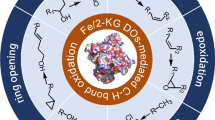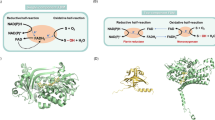Abstract
The asymmetric hydroxylation of inactive carbon atoms is still an important reaction in the industrial synthesis of valuable chiral compounds such as pharmaceuticals and fine chemicals. Applications of monooxygenation enzymes, like cytochrome P450 monooxygenases, flavin-containing monooxygenases, and Fe(II)/α-ketoglutarate-dependent dioxygenases (Fe/αKG-DOs), are strongly desired as hydroxylation biocatalysts because they have great advantages in regio- and stereoselectivity of the reactions. Recently, several novel Fe/αKG-DOs have been found to catalyze the asymmetric hydroxylation of aliphatic amino acids. Depending on their amino acid sequences, these Fe/αKG-DOs catalyze different types of regioselective hydroxylations, or C3–, C4–, and C5-hydroxylation. Additionally, most also have stereoselective sulfoxidation activities. Here, we have reviewed the characterization and process development of this novel functioning group of Fe/αKG-DOs.








Similar content being viewed by others
References
Aoyagi Y, Sugahara T (1988) β-Hydroxy-L-valine from Pleurocybella porrigens. Phytochemistry 27:3306–3307
Augusti KT, Sheela CG (1996) Antiperoxide effect of S-allyl cysteine sulfoxide, an insulin secretagogue, in diabetic rats. Experientia 52:115–119
Becker JE, Moore RE, Moore BS (2004) Cloning, sequencing, and biochemical characterization of the nostocyclopeptide biosynthetic gene cluster: molecular basis for imine macrocyclization. Gene 325:35–42
Bell EA (1980) The non-protein amino acids of higher plants. Endeavour 4:102–107
Berkes D, Kolarovic A, Povazanec F (2000) Stereoselective sodium borohydride reduction, catalyzed by manganese(II) chloride, of γ-oxo-α-amino acids. A practical approach to syn-γ-hydroxy-α-amino acids. Tetrahedron Lett 41:5257–5260
Blaskovich MA, Evindar G, Rose NGW, Wilkinson S, Luo Y, Lajoie GA (1998) Stereoselective synthesis of threo and erythro β-hydroxy and β-disubstituted-β-hydroxy α-amino acids. J Org Chem 63:3631–3646
Broca C, Gross R, Petit P, Sauvaire Y, Manteghetti M, Tournier M, Masiello P, Gomis R, Ribes G (1999) 4-Hydroxyisoleucine: experimental evidence of its insulinotropic and antidiabetic properties. Am J Physiol Endocrinol Metab 277:40–44
Broca C, Manteghetti M, Gross R, Baissac Y, Jacob M, Petit P, Sauvaire Y, Ribes G (2000) 4-Hydroxyisoleucine: effects of synthetic and natural analogues on insulin secretion. Eur J Pharmacol 390:339–345
Ciabatti R, Kettenring JK, Winters G, Tuan G, Zerilli L, Cavalleri B (1989) Ramoplanin (A-16686), a new glycolipodepsipeptide antibiotic. III. Structure elucidation. J Antibiot 42:254–267
Ford PW, Gustafson KR, McKee TC, Shigematsu N, Maurizi LK, Pannell LK, Williams DE, De Silva ED, Lassota P, Allen TM, Van Soest R, Andersen RJ, Boyd MR (1999) Papuamides A-D, HIV-inhibitory and cytotoxic depsipeptides from the sponges Theonella mirabilis and Theonella swinhoei collected in Papua New Guinea. J Am Chem Soc 121:5899–5909
Fowden L (1966) Isolation of γ-hydroxynorvaline from Lathyrus odoratus seed. Nature 209:807–808
Fowden L, Pratt HM, Smith A (1973) 4-Hydroxyisoleucine from seed of Trigonella foenum-graecum. Phytochemistry 12:1707–1711
Gelse K, Poschl E, Aigner T (2003) Collagens—structure, function, and biosynthesis. Adv Drug Deliv Rev 55:1531–1546
Haefele C, Bonfils C, Sauvaire Y (1997) Characterization of a dioxygenase from Trigonella foenum-graecum involved in 4-hydroxyisoleucine biosynthesis. Phytochemistry 44:563–566
Haltli B, Tan Y, Magarvey NA, Wagenaar M, Yin X, Greenstein M, Hucul JA, Zabriskie TM (2005) Investigating β-hydroxyenduracididine formation in the biosynthesis of the mannopeptimycins. Chem Biol 12:1163–1168
Handa T, Yamaguchi K, Sono Y, Yazawa K (2005) Effects of fenugreek seed extract in obese mice fed a high-fat diet. Biosci Biotechnol Biochem 69:1186–1188
Hara R, Kino K (2009) Characterization of novel 2-oxoglutarate dependent dioxygenases converting L-proline to cis-4-hydroxy-L-proline. Biochem Biophys Res Commun 379:882–886
Hausinger RP (2004) Fe(II)/α-ketoglutarate-dependent hydroxylases and related enzymes. Crit Rev Biochem Mol Biol 39:21–68
Helen A, Krishnakumar K, Vijayammal PL, Augusti KT (2003) A comparative study of antioxidants S-allyl cysteine sulfoxide and vitamin E on the damages induced by nicotine in rats. Pharmacology 67:113–117
Hibi M, Kawashima T, Kodera T, Smirnov SV, Sokolov PM, Sugiyama M, Shimizu S, Yokozeki K, Ogawa J (2011) Characterization of Bacillus thuringiensis L-isoleucine dioxygenase for production of useful amino acids. Appl Environ Microbiol 77:6926–6930
Hibi M, Kawashima T, Kasahara T, Sokolov PM, Smirnov SV, Kodera T, Sugiyama M, Shimizu S, Yokozeki K, Ogawa J (2012a) A novel Fe(II)/α-ketoglutarate-dependent dioxygenase from Burkholderia ambifaria has β-hydroxylating activity of N-succinyl L-leucine. Lett Appl Microbiol 55:414–441
Hibi M, Kawashima T, Sokolov PM, Smirnov SV, Kodera T, Sugiyama M, Shimizu S, Yokozeki K, Ogawa J (2012b) L-Leucine 5-hydroxylase of Nostoc punctiforme is a novel type of Fe(II)/α-ketoglutarate-dependent dioxygenase that is useful as a biocatalyst. Appl Microbiol Biotechnol 97:2467–2472
Hibi M, Kawashima T, Yajima H, Smirnov SV, Kodera T, Sugiyama M, Shimizu S, Yokozeki K, Ogawa J (2013) Enzymatic synthesis of chiral amino acid sulfoxides by Fe(II)/α-ketoglutarate-dependent dioxygenase. Tetrahedron Asymmetry 24:990–994
Hoffmann D, Hevel JM, Moore RE, Moore BS (2003) Sequence analysis and biochemical characterization of the nostopeptolide A biosynthetic gene cluster from Nostoc sp. GSV224. Gene 311:171–180
Itokawa Y, Inoue K, Sasagawa S, Fujiwara M (1973) Effect of S-methylcysteine sulfoxide, S-allylcysteine sulfoxide and related sulfur-containing amino acids on lipid metabolism of experimental hypercholesterolemic rats. J Nutr 103:88–92
Johnston RM, Chu LN, Liu M, Goldberg SL, Goswami A, Patel RN (2009) Hydroxylation of L-proline to cis-3-hydroxy-L-proline by recombinant Escherichia coli expressing a synthetic L-proline-3-hydroxylase gene. Enzym Microb Technol 45:484–490
Jokela J, Herfindal L, Wahlsten M, Permi P, Selheim F, Vasconcelos V, Doskeland SO, Sivonen K (2010) A novel cyanobacterial nostocyclopeptide is a potent antitoxin against microcystins. ChemBioChem 11:1594–1599
Kodera T, Smirnov SV, Samsonova NN, Kozlov YI, Koyama R, Hibi M, Ogawa J, Yokozeki K, Shimizu S (2009) A novel L-isoleucine hydroxylating enzyme, L-isoleucine dioxygenase from Bacillus thuringiensis, produces (2S,3R,4S)-4-hydroxyisoleucine. Biochem Biophys Res Commun 390:506–510
Kubec R, Svobodova M, Velisek J (2000) Distribution of S-Alk(en)ylcysteine sulfoxides in some Allium species. Identification of a new flavor precursor: S-ethylcysteine sulfoxide (Ethiin). J Agric Food Chem 48:428–433
Kumari K, Augusti KT (2007) Lipid lowering effect of S-methyl cysteine sulfoxide from Allium cepa Linn in high cholesterol diet fed rats. J Ethnopharmacol 109:367–371
Kyung KH, Han DC, Fleming HP (1997) Antibacterial activity of heated cabbage juice, S-methyl-L-cysteine sulfoxide and methyl methanethiosulfonate. J Food Sci 62:406–409
Lee BC, Gladyshev VN (2011) The biological significance of methionine sulfoxide stereochemistry. Free Radic Biol Med 50:221–227
Luesch H, Hoffmann D, Hevel JM, Becker JE, Golakoti T, Moore RE (2003) Biosynthesis of 4-methylproline in cyanobacteria: cloning of nosE and nosF genes and biochemical characterization of the encoded dehydrogenase and reductase activities. J Org Chem 68:83–91
McBride K, Oulmassov TN, Miller PC, Anderson JC, Crossland LD, Adams T, Gavrias V, McBride KE, Adams TH, Qurollo BA (2001) Polynucleotide that incorporates elements, e.g. promoter comprising an AHL (acetylated homoserine lactone)-response element, of a bacterial quorum sensing system, useful for modulating gene expression in a wide variety of plants and animals. WO200102593-A2
Mori H, Shibasaki T, Yano K, Ozaki A (1997) Purification and cloning of a proline 3-hydroxylase, a novel enzyme which hydroxylates free L-proline to cis-3-hydroxy-L-proline. J Bacteriol 179:5677–5683
Ogawa J, Kodera T, Smirnov SV, Hibi M, Samsonova NN, Koyama R, Yamanaka H, Mano J, Kawashima T, Yokozeki K, Shimizu S (2011) A novel L-isoleucine metabolism in Bacillus thuringiensis generating (2S,3R,4S)-4-hydroxyisoleucine, a potential insulinotropic and anti-obesity amino acid. Appl Microbiol Biotechnol 89:1929–1938
Okai H, Izumiya N (1969) Resolution of amino acids. IX. Studies on the preparation of β-hydroxyasparagines and configuration of natural hydroxyasparagine. Bull Chem Soc Jpn 42:3550–3555
Palomo C, Arrieta A, Cossio FP, Aizpurua JM, Mielgo A, Aurrekoetxea N (1990) Highly stereoselective synthesis of α-hydroxy β-amino acids through β-lactams: application to the synthesis of the taxol and bestatin side chains and related systems. Tetrahedron Lett 31:6429–6432
Perlman D, Perlman KL, Bodanszky M (1977) Microbial production of vitamin B12 antimetabolites. II. 2-amino-4-keto-3-methylpentanoic acids from Bacillus cereus 439. Bioorg Chem 6:263–271
Pflüger M, Kapuscik A, Lucas R, Koppensteiner A, Katzlinger M, Jokela J, Eger A, Jacobi N, Wiesner C, Hofmann E, Önder K, Kopecky J, Schütt W, Hundsberger H (2013) A combined impedance and alfaLISA-based approach to identify anti-inflammatory and barrier-protective compounds in human endothelium. J Biomol Screen 18:67–74
Pilbeam DJ, Bell EA (1979) A reappraisal of the free amino acids in seeds of Crotalaria Juncea (Leguminosae). Phytochemistry 18:320–321
Qin HM, Miyakawa T, Jia MZ, Nakamura A, Ohtsuka J, Xue YL, Kawashima T, Kasahara T, Hibi M, Ogawa J, Tanokura M (2013) Crystal structure of a novel N-substituted L-amino acid dioxygenase from Burkholderia ambifaria AMMD. PloS ONE 8:e63996
Ray B, Chauhan NB, Lahiri DK (2011) Oxidative insults to neurons and synapse are prevented by aged garlic extract and S-allyl-L-cysteine treatment in the neuronal culture and APP-Tg mouse model. J Neurochem 117:388–402
Remuzon P (1996) Trans-4-hydroxy-L-proline, a useful and versatile chiral starting block. Tetrahedron 52:13803–13835
Rose P, Whiteman M, Moore PK, Yi ZZ (2005) Bioactive S-alk(en)yl cysteine sulfoxide metabolites in the genus Allium: the chemistry of potential therapeutic agents. Nat Prod Rep 22:351–368
Rosenthal GA (1982) Plant nonprotein amino and imino acids. Biological, biochemical and toxicological properties. Academic, New York
Salman H, Bergman M, Bessler H, Punsky I, Djaldetti M (1999) Effect of a garlic derivative (alliin) on peripheral blood cell immune responses. Int J Immunopharmacol 21:589–597
Sheldrick GM, Jones PG, Kennard O, Williams DH, Smith GA (1978) Structure of vancomycin and its complex with acetyl-D-alanyl-D-alanine. Nature 271:223–225
Shibasaki T, Mori H, Chiba S, Ozaki A (1999) Microbial proline 4-hydroxylase screening and gene cloning. Appl Environ Microbiol 65:4028–4031
Shibasaki T, Mori H, Ozaki A (2000) Enzymatic production of trans-4-hydroxy-L-proline by regio- and stereospecific hydroxylation of L-proline. Biosci Biotechnol Biochem 64:746–750
Smirnov SV, Kodera T, Samsonova NN, Kotlyarova VA, Rushkevich NY, Kivero AD, Sokolov PM, Hibi M, Ogawa J, Shimizu S (2010) Metabolic engineering of Escherichia coli to produce (2S,3R,4S)-4-hydroxyisoleucine. Appl Microbiol Biotechnol 88:719–726
Stoewsand GS (1995) Bioactive organosulfur phytochemicals in Brassica oleracea vegetables—a review. Food Chem Toxicol 33:537–543
Stopford CR, Wolberg G, Prus KL, Reynolds-Vaughn R, Zimmerman TP (1985) 3-Deazaadenosine-induced disorganization of macrophage microfilaments. Proc Natl Acad Sci U S A 82:4060–4064
Strieker M, Kopp F, Mahlert C, Essen LO, Marahiel MA (2007) Mechanistic and structural basis of stereospecific Cβ-hydroxylation in calcium-dependent antibiotic, a daptomycin-type lipopeptide. ACS Chem Biol 2:187–196
Strieker M, Essen LO, Walsh CT, Marahiel MA (2008) Non-heme hydroxylase engineering for simple enzymatic synthesis of L-threo-hydroxyaspartic acid. ChemBioChem 9:374–376
Takita T, Umezawa Y, S-i S, Morishima H, Umezawa H, Muraoka Y, Suzuki M, Otsuka M, Kobayashi S, Ohno M (1981) Total synthesis of deglyco-bleomycin A2. Tetrahedron Lett 22:671–674
Taniguchi M, Suzumura KI, Nagai K, Kawasaki T, Saito T, Takasaki J, Suzuki KI, Fujita S, Tsukamoto SI (2003) Structure of YM-254890, a novel Gq/11 inhibitor from Chromobacterium sp. QS3666. Tetrahedron 59:4533–4538
Tymiak AA, McCormick TJ, Unger SE (1989) Structure determination of lysobactin, a macrocyclic peptide lactone antibiotic. J Org Chem 54:1149–1157
Wieland T (1968) Poisonous principles of mushrooms of the genus Amanita. Four-carbon amines acting on the central nervous system and cell-destroying cyclic peptides are produced. Science 159:946–952
Yin X, Zabriskie T (2004) VioC is a non-heme iron, α-ketoglutarate-dependent oxygenase that catalyzes the formation of 3S-hydroxy-L-arginine during viomycin biosynthesis. ChemBioChem 5:1274–1277
Author information
Authors and Affiliations
Corresponding author
Rights and permissions
About this article
Cite this article
Hibi, M., Ogawa, J. Characteristics and biotechnology applications of aliphatic amino acid hydroxylases belonging to the Fe(II)/α-ketoglutarate-dependent dioxygenase superfamily. Appl Microbiol Biotechnol 98, 3869–3876 (2014). https://doi.org/10.1007/s00253-014-5620-z
Received:
Revised:
Accepted:
Published:
Issue Date:
DOI: https://doi.org/10.1007/s00253-014-5620-z




